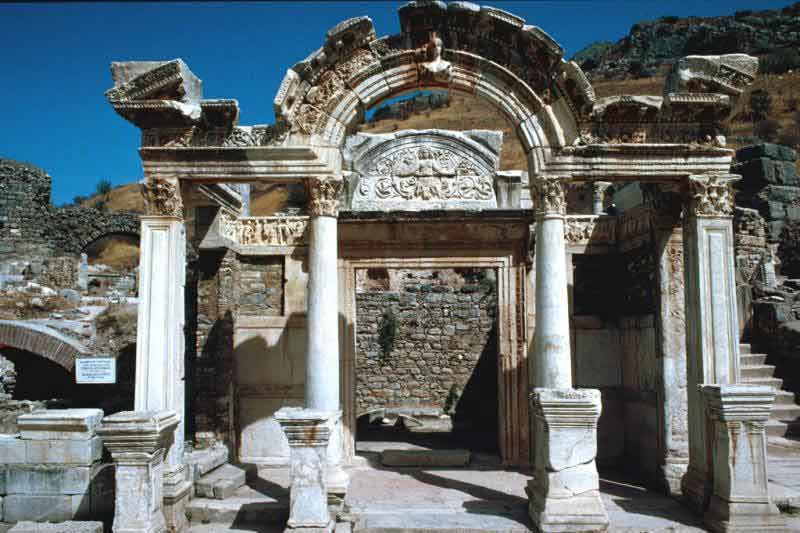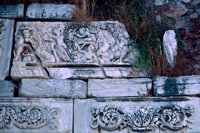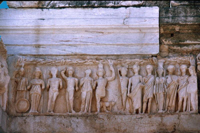It is one of the best preserved and most beautiful structures on Curetes Street. It was built before 138 A.D by P.Quintilius and was dedicated to the Emperor Hadrian, who came to visit the city from Athens in 128 A.D The facade of the temple has four Corinthian columns supporting a curved arch, in the middle of which contains a relief of Tyche, goddess of victory. The side columns are square. The pedestal with inscriptions in front of the temple, are the bases for the statues of the emperors between 293-305 CE, Diocletian, Maximian, Constantius I, and Galerius; the originals of the statues have not been found yet.

History:
Inside the temple above the door, a human figure, probably Medusa stands with ornaments of acanthus leaves. On both sides there are friezes depicting the story of the foundation of Ephesus - Androklos shooting a boar, Dionysus in ceremonial procession and the Amazons. The fourth frieze portrays two male figures, one of which is Apollo; Athena, goddess of the moon; a female figure, Androkles, Herakles, the wife and son of Theodosius and the goddess Athena. The friezes that are seen today are copies, and the originals are displayed in Ephesus Museum.
What to See:
The small, simple structure consists of just a pronaos (porch) and small cella (main hall). The porch is supported by two pillars and two columns of the Corinthian order. The architrave contains the dedicatory inscription from Publius Quintilius to Hadrian, Artemis and the people of Ephesus, and includes a bust of the goddess Tyche, protectress of the city. The pediment and decorative frieze of the pronaos have disappeared.
In the arched tympanum over the main portal is a carving of a half-nude woman surrounded by acanthus leaves; some identify the figure as Medusa, symbolically keeping evil spirits away. The cult statue of Hadrian once stood on a low podium at the end wall of the cella, but has been lost.



The interior of the monument is decorated with panels of reliefs along the top. The ones in place today are plaster replicas of originals protected in the Ephesus Museum.
The first three panels from the left depict the mythological foundation of Ephesus, and show representations of Androklos chasing a boar (part of the founding myth of Ephesus), the battle between Hercules and Theseus, and gods with Amazons. Most of these were taken from a 3rd-century building and placed here in the 4th-century reconstruction.
The fourth panel was created new at the time of the 4th century reconstruction, and is very interesting for the religious history of Ephesus. It shows Emperor Theodosius (who outlawed paganism) and his family surrounded by Athena, Apollo, Androklos, Heracles, Artemis of Ephesus, and several other historical and mythological figures.




The bases in front of the porch facade are inscribed with the names of Galerius, Maximianus, Diocletianus, and Constantius Chlorus, indicating that the bases originally supported statues of these emperors.
The Emperor Hadrian
Emperor Hadrian was one of the Five of Good Emperors. The Five Good Emperors is a term that refers to five consecutive emperors of the Roman Empire— Nerva, Trajan, Hadrian, Antoninus Pius and Marcus Aurelius. The term is first coined by the political philosopher, Niccolò Machiavelli in 1532. Publius Aelius Hadrianus was born on 24 January AD 76, probably at Rome, though his family lived in Italica in Baetica. Emporor Trajan was his cousin. Hadrian was schooled in various subjects particular to young aristocrats of the day, and was so fond of learning Greek literature that he was nicknamed Graeculus ("Little Greek").Hadrian was active in the wars against the Dacians and reputedly won awards from Trajan for his successes. Due to an absence of military action in his reign, Hadrian's military skill is not well attested, however his keen interest and knowledge of the army and his demonstrated skill of administration show possible strategic talent.
Hadrian appears to have been a man of mixed sexual interests.
The Historia Augusta criticizes both his liking of goodlooking young men as well as his adulteries with married women.
It is belived that he tried to poison his wife.
When it comes to Hadrian's homosexuality, then the accounts remain vague and unclear. Most of the attention centres on the young Antinous, whom Hadrian grew very fond of. Statues of Antinous have survived, showing that imperial patronage of this youth extended to having sculptures made of him.
In AD 130 Antinous accompanied Hadrian to Egypt. It was on a trip on the Nile when Antinous met with an early and somewhat mysterious death. Officially, he fell from the boat and drowned.
Hadrian died in 138 on the tenth day of July, in his villa at Baiae at age 62. However, the man who had spent so much of his life traveling had not yet reached his journey's end.
He was buried first at Puteoli, near Baiae, on an estate which had once belonged to Cicero. Soon after, his remains were transferred to Rome and buried in the Gardens of Domitia, close by the almost-complete mausoleum. Upon the completion of the Tomb of Hadrian in Rome in 139 by his successor Antoninus Pius, his body was cremated, and his ashes were placed there together with those of his wife Vibia Sabina and his first adopted son, Lucius Aelius, who also died in 138. Antoninus also had him deified in 139 and given a temple on the Campus Martius.
Poem by Hadrian According to the History Augusta, Hadrian wrote shortly before his death the following poem:
Animula, vagula, blandula
Hospes comesque corporis
Quae nunc abibis in loca
Pallidula, rigida, nudula,
Nec, ut soles, dabis iocos...
Little soul, roamer and charmer
Body's guest and companion
Who soon will depart to places
Darkish, chilly and misty
An end to all your jokes...